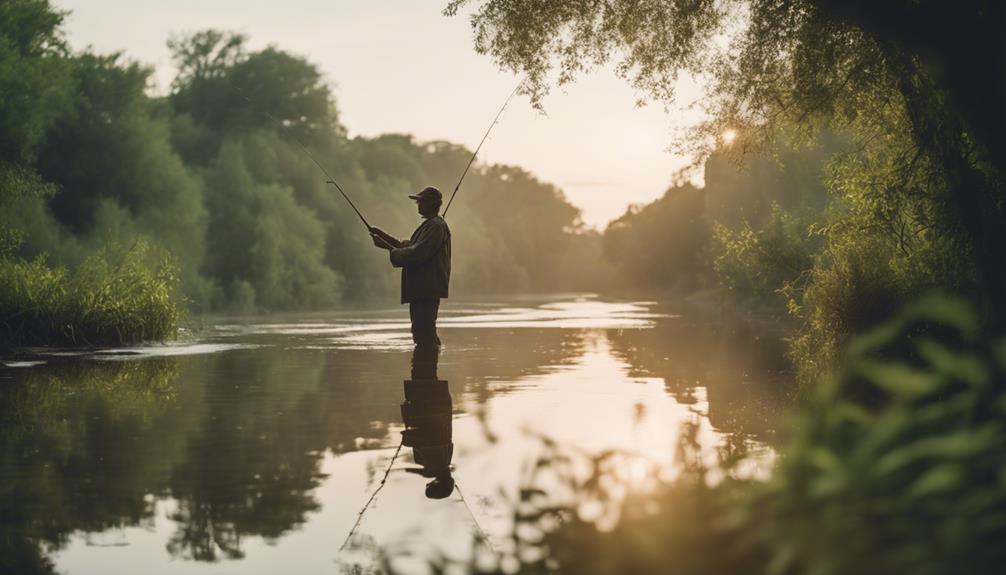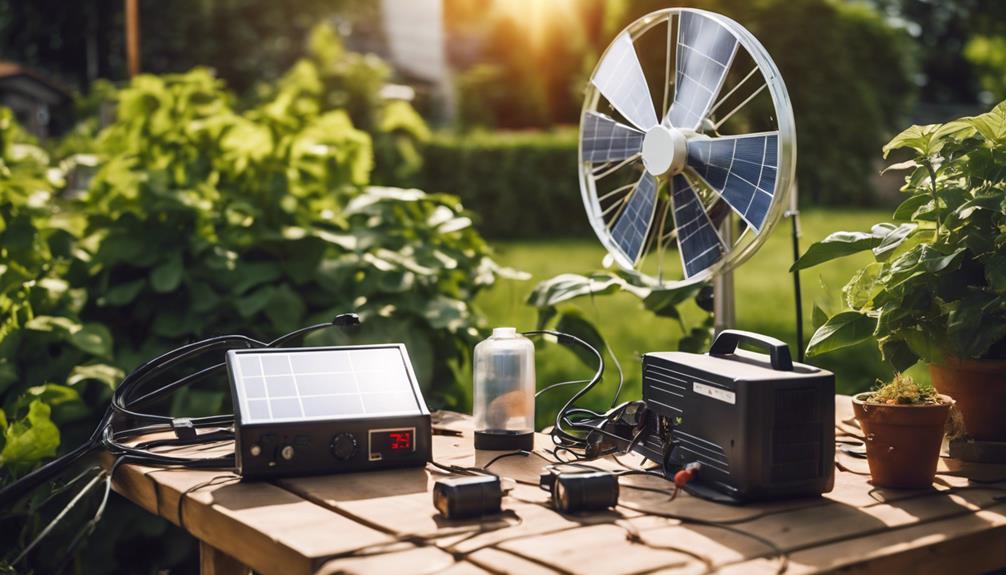You can master survival fishing using simple twigs by turning everyday materials into effective tools. Start by finding flexible twigs about the thickness of your pinky for rods. Use shoelaces or dental floss as fishing lines, and bait with worms or insects you find nearby. Craft a sturdy fishing rod around six feet long, and create hooks from sharp twigs or metal. When you cast, be stealthy to avoid scaring off fish. Pay attention to their behavior, especially before storms. The wilderness holds more secrets for your fishing success, so keep exploring to enhance your skills. To supplement your survival fishing, consider learning other methods for finding food in the wild, such as edible plant identification and trapping small game. By mastering a variety of survival techniques, you can ensure a more reliable source of affordable survival meals in any outdoor situation. Remember, practice makes perfect, so continue honing your skills and experimenting with different methods of obtaining sustenance in the wilderness.
Key Takeaways
- Gather flexible twigs about the thickness of your pinky to create a sturdy fishing rod for survival fishing.
- Use natural materials like shoelaces or dental floss for fishing line, ensuring strength and flexibility.
- Craft hooks from sharp twigs or metal objects, securely attaching them to your fishing line for effective catches.
- Employ natural bait options, such as worms or insects, to attract fish and increase your chances of a successful catch.
Understanding Survival Fishing
Survival fishing is an essential skill that equips you to catch fish in emergency situations, ensuring you have access to fundamental nourishment when other food sources are scarce. This technique isn't just about catching fish; it's about being prepared and resourceful in challenging environments.
Fish provide significant nutrients, making them a nearly perfect food source. Historically, many survival stories emphasize the importance of fishing, showcasing how overlooked fishing opportunities can lead to dire consequences.
Gathering Essential Materials
To successfully gather essential materials for fishing, you'll need to identify suitable twigs, strong alternatives for fishing line, and effective bait options.
Look for flexible twigs about the thickness of your pinky finger; they should bend without breaking.
For fishing line, consider using string, shoelaces, or dental floss, which can hold weight well.
When it comes to bait, natural choices like worms, insects, or even small bits of food work wonders. You can often find worms in damp soil or under rocks. If you're near water, observe the area for potential bait sources.
Crafting Fishing Tools

Once you've gathered the right materials, you can start crafting effective fishing tools that will enhance your chances of catching fish.
First, find a sturdy twig to serve as your fishing rod—about six feet long is ideal.
Next, create a hook using a sharp twig or any metal object, ensuring it can securely hold bait.
For your fishing line, use strong alternatives like shoelaces or dental floss. Attach the hook to one end of the line and secure it tightly.
Don't forget to add bait; insects or worms work best.
Finally, if you can, fashion a small net from finer twigs or leaves for easier catches.
With these tools, you're ready to improve your fishing experience.
Effective Fishing Techniques
Effective fishing techniques can considerably increase your chances of catching fish, especially in challenging conditions.
Start by crafting a twig fishing rod, ensuring it's sturdy yet flexible. Use natural bait like worms or insects, as fish find them irresistible. When casting, be stealthy; sudden movements can scare fish away.
Observe their behavior and feeding patterns—fish often bite more before storms. At night, utilize light sources to attract fish.
Consider creating trotlines for efficient fishing; they allow you to catch multiple fish while you focus on other survival tasks.
Finally, explore deep pools and submerged structures, as they often serve as fish shelters.
Safety and Legal Guidelines

Safety should always be a priority when engaging in survival fishing, ensuring you're aware of potential hazards in natural water bodies. Before you start, familiarize yourself with local fishing regulations to avoid legal issues. Wearing appropriate gear, like a life jacket, can protect you from accidents.
Here's a quick reference table for safety and legal considerations:
| Safety Tips | Legal Guidelines | Emergency Contacts |
|---|---|---|
| Wear a life jacket | Check local regulations | Local authorities |
| Avoid slippery rocks | Obtain necessary permits | Fishing hotline |
| Stay hydrated | Follow catch limits | First aid services |
| Watch for weather changes | Respect protected areas | Emergency services |
Sustainable Fishing Practices
Sustainable fishing practices guarantee that you not only catch fish today but also protect aquatic ecosystems for future generations.
To achieve this, always follow local fishing regulations, including size and bag limits. Use techniques that minimize harm, such as catch-and-release, to ascertain fish populations remain stable.
Avoid overfishing specific species and choose alternatives when possible to prevent ecosystem imbalance. Respect breeding seasons and habitats by fishing responsibly and leaving areas untouched when necessary.
Additionally, consider using non-invasive gear that reduces bycatch and potential damage to aquatic environments.
Resources for Learning

To enhance your survival fishing skills, you can tap into a variety of books, online forums, and local workshops that focus on practical techniques and hands-on experience.
Look for instructional guides that cover everything from crafting your fishing gear to identifying effective bait.
Online forums can provide community support, where you can ask questions and share your experiences with fellow enthusiasts.
Local workshops often offer a chance to learn directly from experts, allowing you to practice techniques in real-world settings.
Don't forget to document your progress; keeping a fishing journal helps reinforce what you've learned.
Frequently Asked Questions
What Types of Fish Are Easiest to Catch for Beginners?
If you're just starting out, focus on catching species like bluegill, perch, or catfish. They're often abundant, easy to find, and less wary, making them perfect targets for beginners looking to gain confidence in fishing.
How Do Weather Conditions Affect Fish Behavior?
Have you noticed how fish act differently when the weather changes? Fish often feed heavily before storms and become sluggish afterward, so monitoring weather can greatly improve your chances of catching them successfully.
Can I Fish in Saltwater Using Survival Techniques?
Yes, you can fish in saltwater using survival techniques. Focus on identifying suitable bait, understanding local fish behavior, and using improvised tools to increase your chances of a successful catch in coastal environments.
What Are the Best Times of Day for Fishing?
The best times for fishing are early morning and late evening. Fish are most active during these hours, seeking food as the water temperature changes. You'll increase your chances of a successful catch by fishing then.
How Do I Identify Fish in Different Water Bodies?
Fish find their food in familiar fields. To identify them, watch water surface movements, observe shadows, and note feeding patterns. Clear, calm conditions often reveal their presence, while murky waters conceal their cunning behavior.
Conclusion
By mastering survival fishing with simple twigs, you're not just learning to catch fish; you're embracing self-reliance and resourcefulness.
You're transforming nature's gifts into tools for sustenance, steering through challenges with creativity and resilience.
Each catch teaches you patience and respect for the environment, while each failure builds your determination and skill.
As you practice these techniques, you're not only securing food but also deepening your connection to the wild, reminding you that survival is both an art and a journey.










